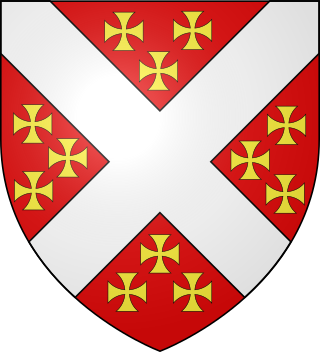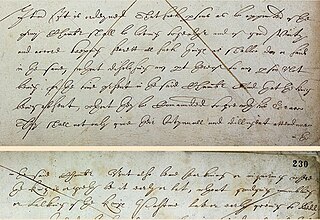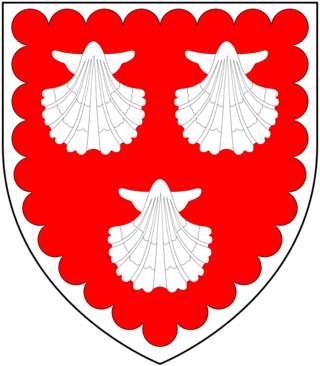
The King's Body Guard of the Yeomen of the Guard is a bodyguard of the British monarch. The oldest British military corps still in existence, it was created by King Henry VII in 1485 after the Battle of Bosworth Field.

Thomas Wriothesley, 1st Earl of Southampton, KG was an English peer, secretary of state, Lord Chancellor and Lord High Admiral. A naturally skilled but unscrupulous and devious politician who changed with the times, Wriothesley served as a loyal instrument of King Henry VIII in the latter's break with the Catholic Church. Richly rewarded with royal gains from the Dissolution of the Monasteries, he nevertheless prosecuted Calvinists and other Protestants when political winds changed.

Sir Anthony Denny was Groom of the Stool to King Henry VIII of England, thus his closest courtier and confidant. In 1539 he was appointed a gentleman of the privy chamber and was its most prominent member in King Henry's last years, having together with his brother-in-law, John Gates, charge of the "dry stamp" of the King's signature, and attended the King on his deathbed. He was a member of the Reformist circle that offset the conservative religious influence of Bishop Gardiner. He was a wealthy man, having acquired several manors and former religious sites distributed by the Court of Augmentations after the Dissolution of the Monasteries.

In the Middle Ages, a squire was the shield- or armour-bearer of a knight.

Sir Ralph Sadler or Sadleir PC, Knight banneret was an English statesman, who served Henry VIII as Privy Councillor, Secretary of State and ambassador to Scotland. Sadler went on to serve Edward VI. Having signed the device settling the crown on Jane Grey in 1553, he was obliged to retire to his estates during the reign of Mary I. Sadler was restored to royal favour during the reign of Elizabeth I, serving as a Privy Councillor and once again participating in Anglo-Scottish diplomacy. He was appointed Chancellor of the Duchy of Lancaster in May 1568.

Catherine Carey, after her marriage Catherine Knollys and later known as both Lady Knollys and Dame Catherine Knollys,, was chief Lady of the Bedchamber to Queen Elizabeth I, who was her first cousin.

The Groom of the Stool was the most intimate of an English monarch's courtiers, initially responsible for assisting the king in excretion and hygiene.
Henry Norris was an English courtier who was Groom of the Stool in the privy chamber of King Henry VIII. While a close servant of the King, he also supported the faction in court led by Queen Anne Boleyn, and when Anne fell out of favour, he was among those accused of treason and adultery with her. He was found guilty and executed, together with the Queen's brother, George Boleyn, Sir Francis Weston, William Brereton and Mark Smeaton. Most historical authorities argue that the accusations were untrue and part of a plot to get rid of Anne.

A privy chamber was the private apartment of a royal residence in England.
Groom of the Chamber was a position in the Household of the monarch in early modern England. Other Ancien Régime royal establishments in Europe had comparable officers, often with similar titles. In France, the Duchy of Burgundy, and in England while French was still the language of the court, the title was varlet or valet de chambre. In German, Danish and Russian the term was "Kammerjunker" and in Swedish the similar "Kammarjunkare".

Sir Nicholas Carew KG, of Beddington in Surrey, was an English courtier and diplomat during the reign of King Henry VIII. He was executed for his alleged part in the Exeter Conspiracy.

Valet de chambre, or varlet de chambre, was a court appointment introduced in the late Middle Ages, common from the 14th century onwards. Royal households had many persons appointed at any time. While some valets simply waited on the patron, or looked after his clothes and other personal needs, itself potentially a powerful and lucrative position, others had more specialized functions. At the most prestigious level it could be akin to a monarch or ruler's personal secretary, as was the case of Anne de Montmorency at the court of Francis I of France. For noblemen pursuing a career as courtiers, like Étienne de Vesc, it was a common early step on the ladder to higher offices.
Sir Francis Bryan was an English courtier and diplomat during the reign of Henry VIII. He was Chief Gentleman of the Privy chamber and Lord Justice of Ireland. Unlike many of his contemporaries, Bryan always retained Henry's favour, achieving this by altering his opinions to conform to the king's. His rakish sexual life and his lack of principle at the time of his cousin Anne Boleyn's downfall led to his earning the nickname the Vicar of Hell.

Sir Michael Stanhope of Shelford in Nottinghamshire, was an influential courtier who was beheaded on Tower Hill, having been convicted of conspiring to assassinate John Dudley, 1st Duke of Northumberland, and others.

Sir Richard Herbert of Ewyas, Herefordshire, was a Welsh knight, gentleman, landowner, and courtier. He was an illegitimate son of William Herbert, 1st Earl of Pembroke (1423–1469), and Maud ap Howell Graunt, a daughter of Adam ap Howell Graunt (Gwynn). Richard had a full brother named George.

Sir William Coffin was a courtier at the court of King Henry VIII of England. He was a Gentleman of the Privy Chamber to King Henry VIII and Master of the Horse to Queen Jane Seymour. He was elected MP for Derbyshire in 1529.
Sir John Gates KB (1504–1553) was an English courtier, soldier and politician, holding influential household positions in the reigns of Henry VIII and Edward VI. As one of the Chief Gentlemen of the Privy Chamber under Edward VI, he became a follower of John Dudley, 1st Duke of Northumberland and was a principal participant in the attempt to establish Lady Jane Grey on the English throne. Because of this, he was executed for high treason under Mary I.
Hugh Denys of Osterley in Middlesex, was a courtier of Kings Henry VII and of the young Henry VIII. As Groom of the Stool to Henry VII, he was one of the King's closest courtiers, his role developing into one of administering the Privy Chamber, a department in control of the royal finances which during Denys's tenure of office also gained control over national fiscal policy. Denys was thus a vital player in facilitating the first Tudor king's controversial fiscal policies.

Sir Richard Weston (1465–1542), KB, of Sutton Place in the parish of Guildford in Surrey, was a courtier and diplomat who served as Governor of Guernsey, Treasurer of Calais and Under-Treasurer of the Exchequer during the reign of King Henry VIII.

Walter Erle (c.1515/20-1581) of Colcombe in the parish of Colyton, of Bindon in the parish of Axmouth, both in Devon, and of Charborough in Dorset, England, was a courtier and servant of the Royal Household to two of the wives of King Henry VIII, namely Catherine Howard and Catherine Parr, and successively to his son King Edward VI (1547-1553) and two daughters, Queen Mary I (1553-1558) and Queen Elizabeth I (1558-1603) during their successive reigns.
















